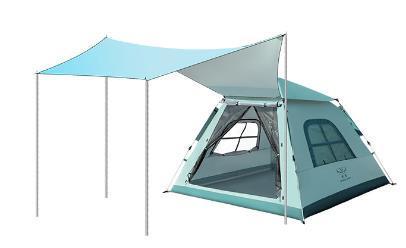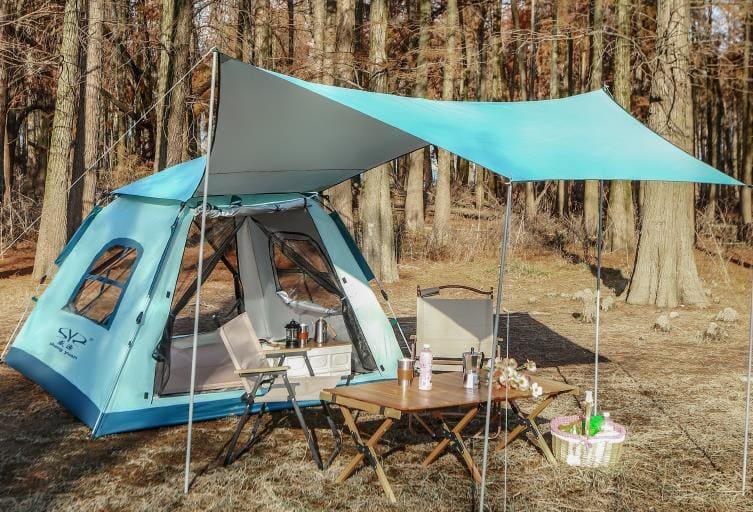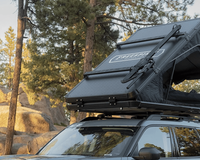Camping is a rewarding escape—an opportunity to reconnect with nature, challenge your self-reliance, and enjoy peaceful nights under the stars. But ask any experienced camper, and they’ll tell you the same truth: your tent can make or break your entire trip. Whether you're facing sudden downpours, mountain gusts, or the unforgiving humidity of a summer night, you’ll want a tent that can handle it all.
Enter the double canopy tent—a thoughtfully engineered solution designed to offer protection, comfort, and adaptability across a wide range of environments. In this article, we'll break down the technical anatomy of double canopy tents, explain why they're preferred by seasoned adventurers, and help you choose the right one for your next journey into the wild.

What Exactly Is a Double Canopy Tent?
At its core, a double canopy tent—also referred to as a double-wall tent—is constructed with two separate layers:
The Inner Tent: Usually made of lightweight and breathable fabric or mesh, this layer allows air to circulate, reduces condensation buildup, and creates a comfortable interior.
The Outer Tent (Rainfly): Made from water-resistant or waterproof fabric, this outer layer acts as a weather shield, protecting against rain, UV rays, and wind.
The key innovation lies in the air gap between the two layers, which functions as thermal insulation and a moisture barrier. When humidity or body heat builds up inside the tent, moisture can escape through the breathable inner tent rather than condensing directly on the shelter walls—a common problem in single-wall tents.
This two-tier structure isn’t just about better performance. It’s also about smarter design for varying weather conditions and longer-term use.
The Advantages of Double Canopy Tents
So why are more outdoor enthusiasts and professionals turning to double canopy tents as their go-to shelters? Here are the most compelling benefits:
1. Superior Moisture Management
Condensation is one of the most frustrating parts of tent camping—especially in humid environments or cooler nights. Double canopy tents tackle this problem by allowing vapor to escape through the inner tent while preventing outside moisture from coming in through the rainfly.
2. All-Weather Protection
Whether you’re camping in a damp forest, a windy plateau, or an alpine meadow, these tents offer stronger resistance to rain, wind, and temperature changes. The outer layer is treated with waterproof coatings and often includes taped seams and extended vestibules to cover gear.
3. Enhanced Comfort and Livability
The breathable inner tent allows for better air circulation, reducing that “stuffy tent” feeling. Many models include large mesh windows, multiple entry points, gear pockets, ceiling loops, and even separate vestibules to improve internal organization and airflow.
4. Customizable Setup
Some models allow you to pitch just the rainfly for an ultra-light shelter or just the inner tent for dry, insect-free star gazing. This modularity provides excellent flexibility for backpackers or campers facing variable conditions.
5. Greater Durability
By distributing wear across two layers, these tents tend to last longer than single-wall tents. The inner tent isn't exposed to UV damage or abrasion, and the rainfly can be replaced if damaged.

When and Where to Use a Double Canopy Tent
Double canopy tents are incredibly versatile and suitable for a wide variety of environments:
Backcountry camping where weight and condensation control are essential.
Wet or tropical regions where humidity is high and airflow is crucial.
Windy highlands or alpine zones, especially models with low-profile, aerodynamic designs.
Family base camps, where larger versions offer multi-room layouts and ample vestibule storage.
Whether you’re embarking on a solo hike across rugged terrain or planning a weeklong family trip to a state park, there's a double canopy tent tailored to your specific needs.
Key Specifications and What to Look For
Understanding technical specs is critical when selecting the right model. Here are the primary features and how they impact real-world usage:
1. Material and Coatings
Rainfly: Usually made of ripstop polyester or nylon with a polyurethane (PU) or silicone coating. Look for waterproof ratings starting at PU2000mm for light rain and PU3000mm or higher for harsher conditions.
Flooring: Should be more rugged than the rainfly; PU5000mm is ideal for wet or muddy environments.
Inner Tent: A balance of mesh and solid fabric provides airflow without sacrificing insulation.
2. Pole System
Aluminum poles are lightweight and more durable than fiberglass. Some models use DAC or 7000-series aluminum, which offers excellent weight-to-strength ratio.
Hubbed pole structures or color-coded clips can greatly simplify setup—especially in bad weather or low light.
3. Ventilation
Roof vents, low vents, and dual-door designs allow for cross-ventilation and moisture control.
Mesh panels should be protected by the rainfly but strategically placed to align with airflow zones.
4. Weight and Packed Size
Backpacking tents typically weigh 1.5–2.5kg and pack down to around 16–18 inches.
Family or car-camping models can weigh 5–10kg or more but provide greater interior space and comfort.
5. Vestibules and Storage
Extra covered areas outside the inner tent let you store gear, cook in light rain, or transition into the tent without tracking in dirt.
Interior features like mesh pockets, gear lofts, and hooks for lights or fans add real-world livability.
Product Examples: Tailored for Every Need
Instant Cabin Tent for 3 to 5 People Waterproof Oxford Canopy Tent

Features:
Spacious Shelter for 3–5 People: Combines a hexagonal canopy and tent to provide approximately 14㎡ of space, ideal for family or group camping in spring, summer, and autumn.
Modular Configuration Options: Offers four setup modes—use the automatic tent alone (pops up in 3 seconds), the canopy alone for shade and airflow, both connected for larger space, or the canopy stacked above the tent for double-layer weather protection.
High Waterproof Performance: Crafted with durable 210D Oxford cloth and a waterproof index of 2000mm–3000mm, ensuring dryness even during heavy rain.
Advanced Sun Protection: Features 5-layer thickened high-density vinyl construction, including heat insulation, UV filtering, and water-repellent coatings—blocks 99% of UV rays and certified with UPF50+ sunscreen rating.
Purchase Link: Instant Cabin Tent for 3 to 5 People Waterproof Oxford Canopy Tent
Amflip Dome Tent Pop Up Ultralight Camping Tent for 2-3 People

Features:
Superior Weather Protection: Constructed with 210T polyester fabric, PU3000mm waterproof rating, and sealed seams for excellent rainproof performance in all conditions.
Strong Wind Resistance: Reinforced double-layer structure and wind-resistant stake loops ensure stability in rough terrain and high winds.
Dual Door Convenience: Two D-shaped doors with roll-up curtains offer easy access, privacy, and enhanced airflow.
Reliable Structure: Corrosion-resistant fiberglass poles and durable buckles provide a strong and stable frame.
Purchase Link: Amflip Dome Tent Pop Up Ultralight Camping Tent for 2-3 People
Copper Spur HV UL3 Tent

Features:
Smart Structure and Easy Setup: The innovative TipLok™ Tent Buckle combines pole-tip capture, rainfly attachment, and stake-out loop into a single streamlined system, simplifying setup and boosting stability in all conditions.
Expanded Living Space: Dual awning-style vestibules offer extra covered area for cooking or gear storage, while the interior maximizes livable space with pre-bent poles, a high-volume angle hub, and smart pocket systems including a 3D gear bin and ceiling storage.
Durable Ultralight Build: Crafted from double ripstop, mixed-denier nylon for enhanced tear and puncture resistance—engineered to remain ultralight and compact (minimum trail weight: 3 lbs. 8 oz.).
Advanced Weather Protection: Waterproof seams, stormflaps, and hook-and-loop closures keep the interior dry; dual-zip vestibule doors and vents optimize airflow to reduce condensation in any weather.
Purchase Link: Copper Spur HV UL3 Tent
Pro Tips for Using Your Double Canopy Tent
Always stake out the rainfly fully to maintain ventilation and prevent sagging from condensation.
Leave a small gap between the inner and outer layers to keep airflow moving.
Practice setup at home before your trip, especially for tents with multiple poles or vestibule configurations.
Use a groundsheet to prolong the life of your tent floor, even if the material is waterproof.
Ventilate even in rain: Use the vents! It may feel counterintuitive, but airflow reduces condensation even during storms.
Final Thoughts
The double canopy tent is more than just a piece of gear—it’s a reliable partner in the wilderness. It allows you to confidently sleep through storms, wake up dry in humid forests, and stay cool during summer nights. Its thoughtful two-layer design solves several of the most persistent problems in outdoor sheltering, from condensation to ventilation to adaptability.
Whether you're investing in your first quality tent or upgrading for a long-distance hiking journey, a double canopy model is a smart, versatile, and field-tested choice. With the right one, you'll not only survive in the outdoors—you’ll thrive in it.












